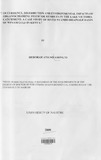Occurrence, distribution and environmental impact of organochlorine pesticide resedues in the Lake Victoria catchment: a case study of River Nyando drainage basin of Winam Gulf in Kenya

View/
Date
2009Author
Abong'o, Deborah Atieno
Type
ThesisLanguage
enMetadata
Show full item recordAbstract
The study was to investigate the impacts on the ecosystem health in relation to levels and distribution of organochlorine pesticides that have either been banned or restricted for use in Kenya. The pesticides targeted were DDT, lindane, aldrin, dieldrin, heptachlor, endrin, endosuphan, and methoxychlor. Prior to their ban or restriction in use, they had found wide applications in public health and agriculture for control of disease vectors and crop pests respectively. A study was conducted in which 880 samples of soil, water, sediments, aquatic weeds and benthic macroinvertebrates were collected from 26 locations representative of the River Nyando drainage basin catchment area of 3450 km2 and a total length of 170 km of the Lake Victoria Catchment over a period of two years. Soils from six farms were sampled in areas where maize, tea, sugar cane, col fee, rice and vegetables have been grown over the years. The objective was to investigate the impacts on the ecosystem health in relation to levels and distribution of oraganochlorine pesticides that have either been banned or are restricted for use in Kenya. The pesticides targeted were DDT, lindane, aldrin, dieldrin, heptachlor, endrin, endosulfan and methoxychlor. Pior to their ban or restriction in use, they had found wide applications in public health and agriculture for control of disease vectors and crop pests respectively.
Analysis of 48 soil samples revealed presence of all the targeted pesticides. Mean concentrations (pg/kg) recorded decreased in the order methoxychlor (138.97±1.517 pg/kg), total (X) endosulfan (30.267±2.098pg/kg), £DDT (17.513± 1.689 pg/kg), dieldrin (14.073±0.440 pg/kg), endrin (10.155±0.860 pg/kg), lindane (8.985±1.318 pg/kg) and ^Heptachlor (0.681±0.021 pg/kg), respectively. The distribution showed that dieldrin was in use in vegetable farms in Kedowa area, tea farms in Nandi District and in Ahero rice paddies; while p-endosulfan was commonly used on tea farms in Nandi. Water analysis from the 26 sampling sites showed the highest mean concentrations were detected for methoxychlor (8.817±0.020 pg/L), ^endosulfan (1.648± 0.04 pg/L), dieldrin (1.1561± 0.042 pg/L), endrin (0.281± 0.003 pg/L), £DDT (0.242±0.009 pg/L), £heptachlor (0.148±0.01 lpg/L) and lindane (0.144±0.006pg/L) respectively. The detected levels in sediments were considerably higher than those found in
water in the order, methoxychlor (92.893±3.039 pg/kg ), lindane (33.917±2.360 pg/kg), aldrin (26.676±0.981 pg/kg ), dieldrin (23.62±4.810 pg/kg) and P-endosulfan, (10.502±0.800 pg/kg), respectively. The analysis of aquatic weeds recorded methoxychlor (39.641±3.045 pg/kg) as the highest residue concentrations, followed by aldrin (15.519±3.756 pg/kg). These higher levels may be as a result of continued use of the pesticide in the drainage basin. The levels of pesticides were higher in sediment, weeds and soil than in water.
The pooled results show that the targeted pesticides are still in use in the basin and could be impacting negatively on the ecosystem health of the area. A study of the composition of the benthic macroinvertebrates showed presence of four invertebrate phyla in River Nyando. These were Arthropoda, Mollusca, Plathelminthes and Annelida. A diversity of 16 families and eleven orders was recorded, with the order Ephemeroptera being abundant upstream followed by Hemiptera, Plecoptera and Trichoptera respectively. The downstream sections mainly the rice farming areas were dominated by Hirudinae (leaches) and Oligochaeta, suggesting that they are less sensitive to environmental pollution. Using Multivariate analytical techniques, Redundancy Analysis and Canonical Correspondence Analysis, correlation statistics showed that the occurrence of organochlorine pesticides strongly affects the distribution of the benthic macro invertebrates at all the sampling locations within the drainage basin. The high concentrations of pesticide residues were detected mostly in the soils and water from rice farms, these magnitudes were followed by those from tea farms. This implies that the rice farmers use most pesticides followed by tea farmers and there the proximity of the rice paddies to Lake Victoria could pose a greater impact to ecosystem health in the entire catchment than the upstream tea, sugar cane, maize and coffee farms owing to pesticide discharge; and this call for stringent management measures to be put in place to safeguard the environment.
Sponsorhip
University of NairobiPublisher
University of Nairobi
Description
(data migrated from the old repository's GRL collection)
